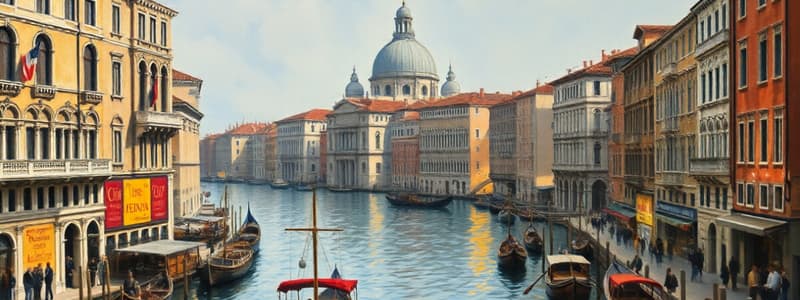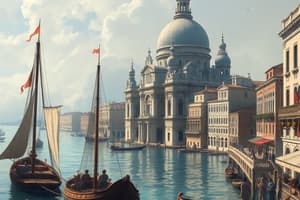Podcast
Questions and Answers
What were some of the primary goods traded by Venetian merchants during the Middle Ages?
What were some of the primary goods traded by Venetian merchants during the Middle Ages?
- Silver and glassware (correct)
- Porcelain and spices (correct)
- Woolen cloth and tea
- Silk and wine (correct)
What is the significance of the Grand Canal in Venice?
What is the significance of the Grand Canal in Venice?
- It is the largest bridge in the city.
- It is the only canal in Venice.
- It is a historic site for battles.
- It serves as a main transportation route. (correct)
Which artist is considered the greatest Venetian artist of the 1500s?
Which artist is considered the greatest Venetian artist of the 1500s?
- Titian (correct)
- Tintoretto
- Raphael
- Caravaggio
What role did wealthy Venetians play during the Renaissance?
What role did wealthy Venetians play during the Renaissance?
What characterizes the city of Venice's layout?
What characterizes the city of Venice's layout?
Flashcards
Venice
Venice
A city-state located on the Adriatic Sea, known for its maritime trade during the Renaissance.
Canals
Canals
A network of waterways that crisscrossed the city of Venice, connecting its islands.
St. Mark's Square
St. Mark's Square
The central public space in Venice, surrounded by important buildings and bustling with activity.
Gondola
Gondola
Signup and view all the flashcards
Titian
Titian
Signup and view all the flashcards
Study Notes
Venice: A Trading Hub and Artistic Center
- Venice, a city-state in northern Italy, was a significant trading center during the Renaissance.
- Located on the Adriatic Sea, its strategic position facilitated trade between Europe and Asia.
- Venetian merchants traded extensively with Constantinople and China in the Middle Ages.
- Trade goods included European silver, wine, wool, Venetian glass, and Eastern silk, porcelain, and spices.
- By the 1400s, Venice had a powerful navy and controlled neighboring city-states.
- Venice's wealth allowed significant patronage of Renaissance artists.
Venice's Unique Urban Design
- Venice is a city built on over 100 small islands.
- Canals connect these islands, forming a network of waterways.
- The Grand Canal, a prominent waterway, stretches through the city for about 2 miles.
- Gondolas, long flat-bottomed boats, were used for transportation.
- St. Mark's Square, with its flocks of pigeons, serves as a central public area.
Venetian Art
- Titian, a prominent 16th-century Venetian artist, was famed for his vibrant colors and ability to portray personalities in his portraits.
- Titian's artwork frequently depicted mythological and religious themes, in addition to portraits.
- Charles V at Mühlberg (1548 CE) is a notable example of Titian's work.
Studying That Suits You
Use AI to generate personalized quizzes and flashcards to suit your learning preferences.




